The New Normal for Oil?
Commodities / Crude Oil Jan 13, 2015 - 04:24 PM GMTBy: Marin_Katusa
 You may have come across the word “contango” in an oil-related news report or article recently and wondered, “What’s contango?”
You may have come across the word “contango” in an oil-related news report or article recently and wondered, “What’s contango?”
It isn’t the Chinese version of the tango.
Contango is a condition in a commodity market where the futures price for the commodity is higher than the current spot price. Essentially, the future price of oil is higher than what oil is worth today.
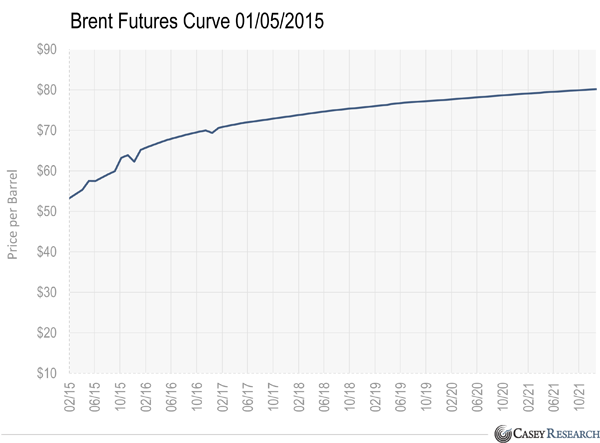
The above forward curve on oil is what contango looks like. There’s more value placed on a barrel of oil tomorrow and in the future than over a barrel today because of the increased value of storage.
I personally believe our resource portfolios are in portfolio contango—but that’s an entirely separate discussion that I’ll get to later. In today’s missive, I want to focus entirely on oil contango.
Crude oil under $50 per barrel may seem to put most of the producers out of business, but many oil and gas exploring and producing (E&P) companies are sheltered from falling prices in the form of hedges. Often, companies will lock in a price for their future production in form of a futures commodity contract. This provides the company with price stability, as it’s sure to realize the price it locked in at some future date when it must deliver its oil.
But the market will always figure out a way to make money—and here’s one opportunity: the current oil contango leads to plenty of demand for storage of that extra oil production.
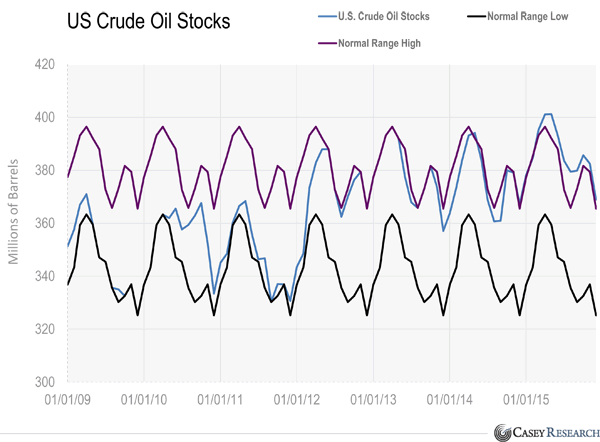
With US shale being one of the main culprits of excess crude oil production, storage of crude in US markets have risen above seasonally adjusted highs in the last year. This abundance of stored crude has pushed the current spot price of crude oil toward five-year lows, as current demand is just not there to take on more crude production.
When in contango, a guaranteed result is an increase in demand for cheap storage of the commodity, in order to clip the profit between the higher commodity price in the future versus what’s being paid for the commodity at present. This is precisely what’ playing out in oil today.
Contago, Five Years Later
Looking back at the similarities of the 2009 dramatic free-fall in oil prices to $35 per barrel, after a five-year hiatus, crude has returned to a similar price point, and the futures market has returned to contango (green shows oil in contango).
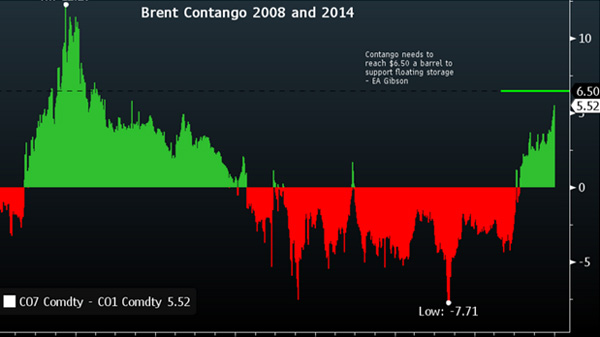
Floating Storage Is Back in Vogue
Oil traders are now taking advantage of the contango curve through floating storage in the form of waterborne oil tankers.
This is what a big oil tanker looks like:
I’m personally reminded of contango whenever I look out my living room window:
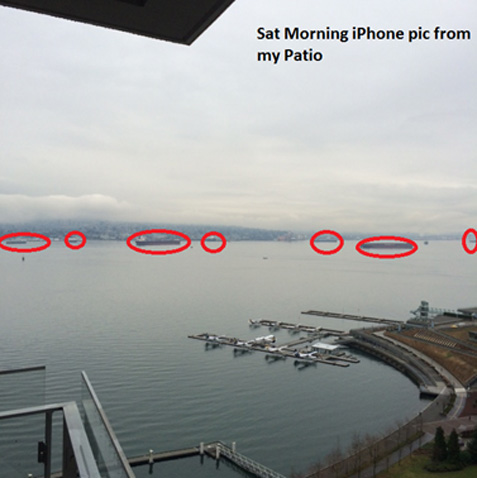
Here’s a photo taken out my living room window—and this is non-busy part of the harbor. At times when I do my runs along the seawall, there have been up to 30 large oil tankers just sitting in the harbor. (On a side note, Olivier and I went for a run in July along the Vancouver seawall, and we counted 26 oil tankers.) All that pricey Vancouver waterfront will have an incredible view of even more oil tankers in the years to come when the pipelines are eventually built. I can only imagine what the major import harbors of China and the US look like… never mind the number of oil tankers sitting in the export nations’ harbors and the Strait of Hormuz. Multiply the above by at least 50 red circles.
As the spread between future delivery of oil and the spot price widened, traders looking to profit from the spread would purchase crude at spot prices and store it on oil tanker ships out at sea. The difference between the spread and the cost to store the crude per barrel is referred to as the arbitrage profit taken by traders. Scale is a very important factor in crude storage at sea: therefore, traders used very large crude carriers (VLCC) and Suezmax ships that hold between 1-2 million barrels of crude oil.
In the late summer of 2014, rates charged for crude tankers began to climb to yearly highs because of the lower price that spurred hoarding of crude oil. This encouraged VLCCs to lock in one-year time charter rates close to and above their breakeven costs to operate the ship.
Time charter rates share similarities to the oil futures market, as ships are able to lock in a daily rate for the use of their ships over a fairly long period of time. VLCC spot rates have reached around $51,000 per day; however, these rates tend to be booked for a shorter period of around three months. These higher spot rates tend to reflect the higher cost paid to crew a VLCC currently against locking in crew and operating costs over a longer-term charter that could last a year. Crude oil is often stored on floating VLCCs for periods of six months to a year depending, on the contango spread.
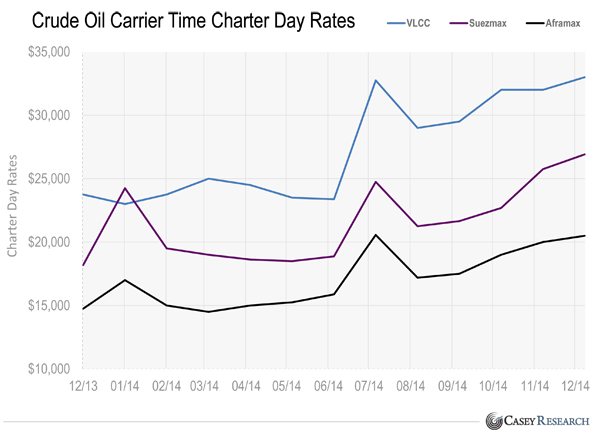
Floating Storage: Economics
Many VLCCs are locking in yearlong time charter rates at or above $30,000-$33,000 per day, as that tends to be the breakeven rate to operate the vessel. If we assume that a VLCCs charge their breakeven charter rate and we include insurance, fuel, and financing costs that would be paid by the charterer, storage on most VLCCs in the 1-2 million barrel ranges are barely economic at best.
However, they’ll soon become profitable across the board once the oil futures and spot price spread widens above $6-$7 per barrel.

The red star depicts the current spread between the six-month futures contract from the futures price in February 2015. Currently companies are losing just under $0.20 per barrel storing crude for delivery in six months. However, once that $6-$7 hurdle spread is achieved, most VLCCs carrying 2 million barrels of crude will be economic to take advantage of the arbitrage in the contango futures curve.
The VLCC and ULCC Market
VLCC= Very Large Crude Carrier
ULCC=Ultra-Large Crude Carrier
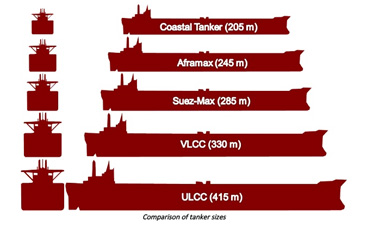
VLCCs store 1.25-2 million barrels of oil for each cargo. Globally, there are 634 VLCCs with around 1.2 billion barrels of storage capacity, or over one-third of the US’s total oil production. The VLCC market is fairly fractioned, and the largest fleet of VLCCs by a publicly traded company belongs to Frontline Ltd. with 25 VLCCs. The largest private-company VLCC fleet belongs to Tankers International with 37 VLCCs. In early December, Frontline and Tankers International created a joint venture to control around 10% of the VLCC market. Other smaller VLCC fleets belong to DHT with 16 VLCCS, and Navios Maritime with 8 VLCCs.
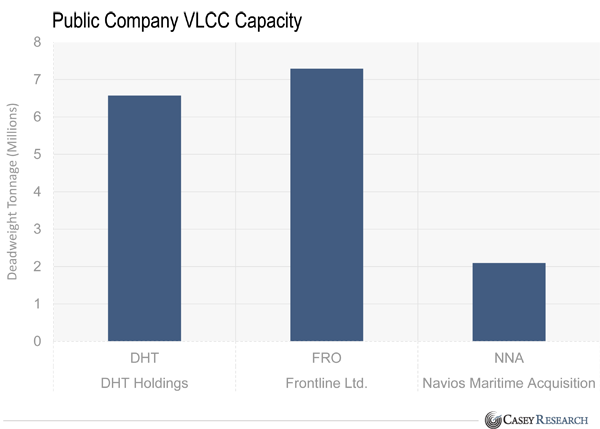
The lowest time charter breakeven costs of $24,000 per day are associated with the largest VLCC fleet from Frontline Ltd. and Tankers International. This is followed by the smaller fleets that have time charter breakeven costs of around $29,000 per day. Of course, on average the breakeven costs associated with most VLCCs is around $30,000 per day, and current time charter rates are around $33,000.
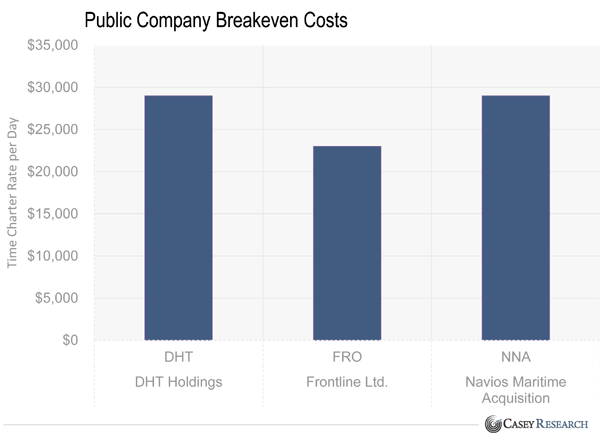
Investing in companies with VLCC fleets as the contango trade develops can generate great potential for further profits for investors. The focus of these investments would be between the publicly traded companies DHT Holdings, Frontline Ltd., and Navios Maritime.
But one must consider that investing in these companies can be very volatile because of the forward curve’s ability to quickly change. It isn’t for the faint of heart.
However, if current oil prices stay low, there will be an increase in tanker storage and thus a sustained increase in the spot price of VLCCs. However, eventually low prices cure low prices, and the market goes from contango to backwardation. It always does and always will.
Shipping companies have been burdened by unprofitable spot and charter pricing since the financial crisis, and these rates have only recently started to increase.
Warning!
As I sit here on a Saturday morning writing this missive, I want to remind all investors now betting on this play that they’re actually speculating, not investing.
There’s a lot of risk for one to think playing the tankers is a sure bet. I have a pretty large network of professional traders and resource investors, and I do not want to see the retail crowd get caught on the wrong side of the contango situation.
In the past, spot rates for the VLCCs usually decline into February and have dropped to as low as under $20,000 per day. It is entirely possible that if the day rates of VLCCs go back to 2012-2013 levels, operators will lose money.
Conclusion: this speculation on tankers is entirely dependent on the spot price and the forward curve.
The risk of this short-term trade is that these companies are heavily levered, and some are just hanging on by a thread. Although this seasonal boost to spot rates has been a positive for VLCCs and other crude carriers, the levered nature of these companies could spell financial disaster or bankruptcy if spot rates return to 2012-2013 levels.
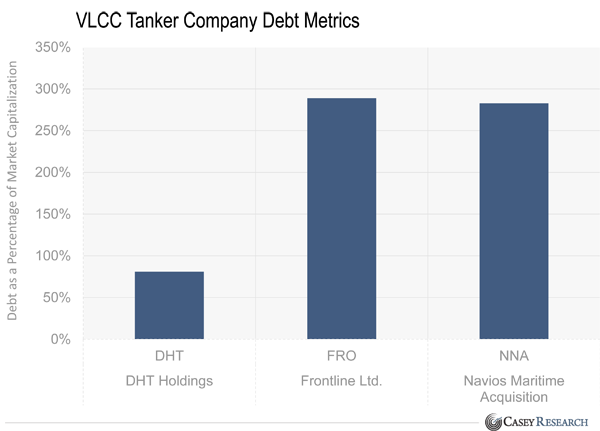
What should be stressed are the similarities to the short-lived gas rally in the winter of 2013-‘14, and the effect these prices have had on North American natural gas companies. A specific event similar to the polar vortex has occurred in the oil market, which has spurred a seasonal increase in the spot price tankers charge to move and store oil.
However, much like the North American natural gas market, the VLCC market is oversupplied; a temporary increase in spot prices that have led to increased transport and storage of oil will not be enough to lift these carriers from choppy waters ahead. Future VLCC supplies are expected to rise, with 20 net VLCCs being built and delivered in 2015 and 33 in 2016. This is much more than the 17 net VLCCs added in 2013 and 9 in 2014.
Another looming and very possible threat to these companies is the same debt threat that affected energy debt markets as global oil prices plummeted. If VLCC and other crude carriers experience a fall in spot prices, these companies’ junk debt could be downgraded to some of the lowest debt grades that border a default rating. This will increase financing costs and in turn increase the operating breakeven costs to operate these crude carrying vessels. The supply factor, high debt, and potentially short-lived seasonally high spot market could all affect the long-term appreciation of these VLCC stock prices. Investing in these companies is very risky over the long run, but a possible trade exists if storage and transport of oil continues to increase for these crude carriers.
Portfolio Contango—An Opportunity Not Seen in Decades
If you talk to resource industry titans—the ones who’ve made hundreds of millions of dollars and been in the sector for 40 years—they’re now saying that they’ve never seen the resource share prices this bad.
Brokerage firms focused on the resource sector have not just laid off most of their staffs, but many have shut their doors.
The young talent is the first group to be laid off, and there’s a serious crisis developing in the sector, as many of the smart young guns have left the sector to claim their fortunes in other sectors.
There’s blood in the streets in the resource sector.
Now if you believe that, as I do, to be successful in the resource sector one must be a contrarian to be rich, now is the time to act.
I have invested more money in the junior resource sector in the last six months than I have in the last five years. I believe we’re in contango for resource stocks, meaning that the future price of the best juniors will be worth much more than they are currently.
I have my rules in speculating, and you’ll learn from my experience—and more important, my network of the smartest and most successful resource mentors whom I have shadowed for many years.
So how can we profit from the blood in these markets? Easy.
Take on my “Katusa Challenge.” You’ll get access to every Casey Energy Report newsletter I’ve written in the last decade, and my current recommendations with specific price and timing guidance. There’s no risk to you: if you don’t like the Casey Energy Report or don’t make any money over your first three months, just cancel within that time for a full, prompt refund, no questions asked. Even if you miss the three-month cutoff, cancel anytime for a prorated refund on the unused part of your subscription.
As a subscriber, you’ll receive instant access to our current issue, which details how to protect yourself from falling oil prices, plus our current top recommendations in the oil patch. Do your portfolio a favor and have me on your side to increase your chances of success.
I can’t make the trade for you, but I can help you help yourself. I’m making big bets—are you ready to step up and join me?
Casey Research Archive |
© 2005-2022 http://www.MarketOracle.co.uk - The Market Oracle is a FREE Daily Financial Markets Analysis & Forecasting online publication.



